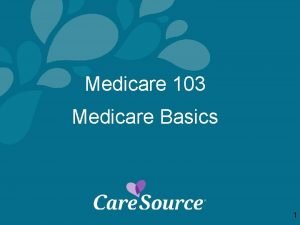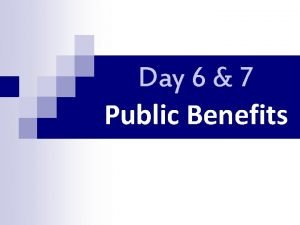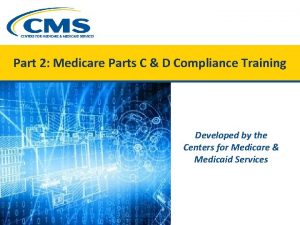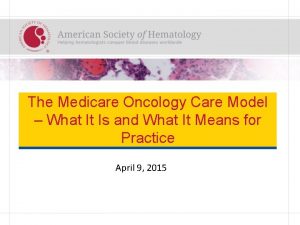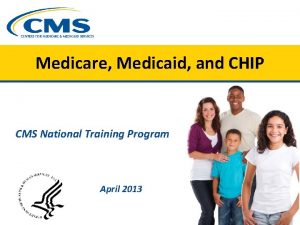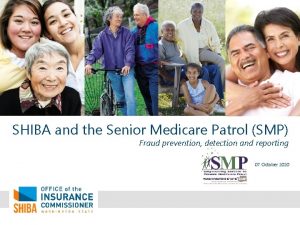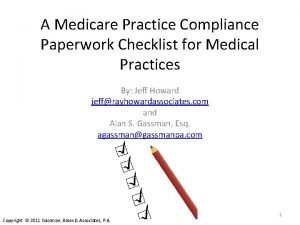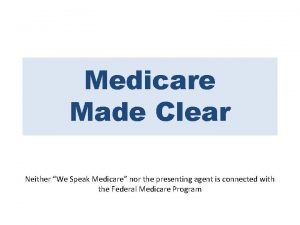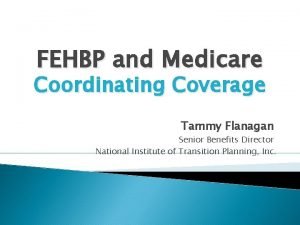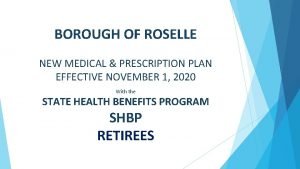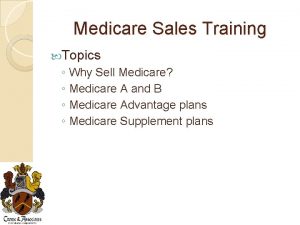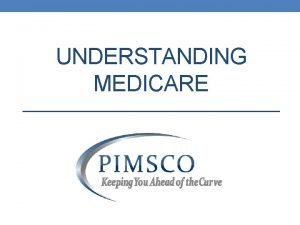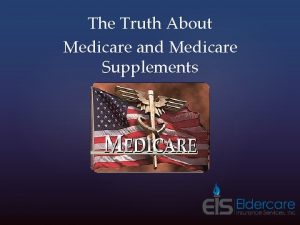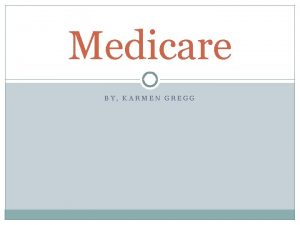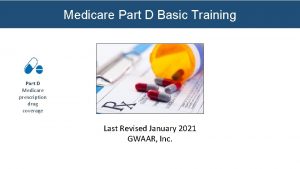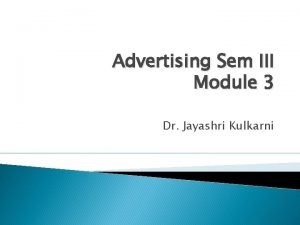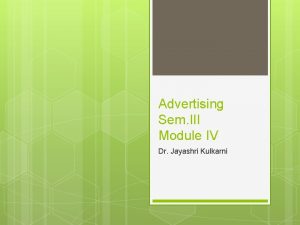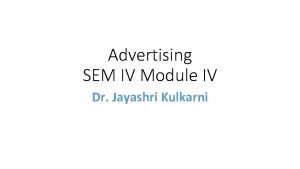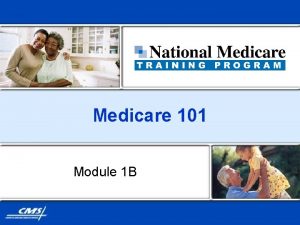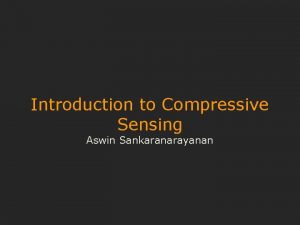Medicare Part D Cases Module 3 Jayashri Sankaranarayanan

















- Slides: 17

Medicare Part D Cases Module #3 Jayashri Sankaranarayanan Ph. D Assistant Professor Department of Pharmacy Practice, College of pharmacy University of Nebraska Medical Center jsankara@unmc. edu Phone: 402 -559 -5267 1

PROCESS A series of modules and questions Step #1: Power point module with voice overlay Step #2: Case-based question and answer Step # 3: Proceed to additional modules or take a break 2

Objectives Three module Overview Upon completion the learner will be able to describe: • The Medicare Program, its eligibility and various health insurance options • The new Medicare D, Outpatient Prescription Drug Benefit in terms of eligibility criteria, the cost benefit structure, drugs covered and enrollment process • Guidance that can be given to the Medicare beneficiaries in various case scenarios 3

Decisions for Medicare Beneficiaries, 2006 Enroll in Part D Plan Medicare Advantage (MA-PD) Traditional Medicare No Part D coverage Part D Prescription Drug Plan (PDP) HMO PPO Private Fee(local) (regional) for-Service Apply for Low-Income Subsidy Dual Eligibles Social Security Office Medicaid Office Meet Income and Resource Test? If yes, qualify for: Below 100% FPL: Below 135% FPL: Below 150% FPL: No premium or deductible, $1/generic Rx, $3/brand name Rx, pay nothing after $5, 100 in Rx costs Subsidy for premium, no deductible, $2/generic Rx, $5/brand name Rx, pay nothing after $5, 100 in Rx costs Subsidy for premium on sliding scale, $50 deductible, 15% coinsurance to $5, 100 in Rx costs, $2/generic Rx, $5/brand 4 name Rx after $5, 100

Medicare Part D Options for Beneficiaries • Medicare Advantage (MA) changes to MA-PD* which has drug coverage (Part D) – Medicare HMO and Others (private fee-for-service plan, preferred provider organizations, provider sponsored organizations) • Traditional Medicare (Part A and B)+ Medigap** (without drug coverage) + PDP (Part D) • Traditional Medicare + Medicaid (“duals” for non Part D drugs) + PDP (for Part D drugs only) • Traditional Medicare (or MA) + retiree plan (only for selected individuals) can consider PDP (or MA-PD) if retiree plan not creditable * Formerly known as MA without drug coverage / M+ C/ Part C, ** Medigap; Medicare supplemental private insurance intended to fill the “gaps” in traditional Medicare may or may not be sold, issued or renewed on or after 1/1/06 5

Medicare Beneficiary Cases l Case Study 1 - Patient without prior prescription coverage enrolling in the standard benefit – enroll to avoid future penalties l Case Study 2 a, 2 b and 2 c - Patient who receive creditable prescription coverage from a former employer (retiree) or other sources (TRICARE/VA). l Case study 3 - Patient without prior prescription coverage qualifying for low income subsidy and enrolling for the low-income benefit l Case study 4 - Patient with prior Medicaid prescription coverage. l Case Study 5 - Patient in a long-term care or assisted living facility l Case Study 6 - Patient in a Medigap plan l Case Study 7 - Patient in a Medicare Advantage plan 6

Case Study - 1 John is a senior with no prior prescription drug coverage since he does not take any medications and is in good health. He asks why does he need to enroll into a Medicare Part D plan? What are important things for him to know? 1. 2. 3. 4. His current state of no prescription drug coverage is not “Creditable. ” It is in his interest to enroll into a least expensive plan to avoid future penalties on late enrollment and to have some protection from future unanticipated drug expenses incurred. No automatic enrollment if he does not enroll Standard benefit (Premium, Out of pocket costs), low income subsidy application process and yearly enrollment dates. 7

Case Study - 2 a Jim is a senior with retiree coverage. He asks you about Medicare Part D enrollment decision What are important things for him to know? 1. His current plan has to inform whether his current coverage is “Creditable. ” If they do not inform him, he has to contact his plan. 2. If his current coverage is creditable, he can switch later without penalty on late enrollment 3. No automatic enrollment if he does not enroll 4. Can supplement with a less expensive PDP but check with retiree coverage administrator before enrolling, because you cannot regain retiree coverage that is dropped or lost 8 5. Standard benefit - Premium, Out of pocket costs, and

Case Study - 2 b Beth is a senior with TRICARE or FEHBP coverage, who asks you about Medicare Part D enrollment decision What are important things for her to know? For individuals with current prescription drug coverage through TRICARE, or FEHBP – It is advisable to keep current coverage without any changes, because it is creditable. – However, those with limited income and resources, may qualify for extra help from Medicare. – Contact benefits administrator or FEHBP insurer for information about TRICARE, or FEHB coverage before making any changes. 9

Case Study - 2 c Ed is a senior with VA coverage, who asks you about Medicare Part D enrollment decision What are important things for his to know? 1. For individuals with current prescription drug coverage through the VA – – – It is advisable to keep current coverage without any changes. However, those with limited income and resources, may qualify for extra help from Medicare. Contact the VA benefits administrator for information about VA coverage before making any changes. 2. VA beneficiaries can enroll in the new Medicare prescription plan in addition to VA benefits for the convenience and choice of getting prescriptions written by non-VA providers and filled by local pharmacies outside the VA system. 10

Case Study - 3 Jack is a Medicare beneficiary with limited income and resources, who asks about Medicare Part D What are important things for him to know? 1. Can apply for low income subsidy anytime using income and resource information 2. Duals (Medicare + Medicaid) beneficiary (need not apply) while non duals low income and resource beneficiary (need to apply to SSA) and then enroll in a plan too. 3. Benefit – Premium, Deductible, Co-insurance/Co-payment depends on marital status, family size and federal poverty level (determined by income and resources) 11

Case Study - 4 Peggy is a Medicare dual beneficiary, who asks about Medicare Part D benefit for dual eligibles. What are important things we can tell her? 1. Dual eligibles (Medicare + Medicaid) automatically qualify for extra help (i. e. low income subsidy and do not need to apply to SSA) 2. Duals pay no premium or deductible but do have to pay small co-payment, (if they are not living in nursing homes or assisted living facility). 3. If duals did not choose to enroll in a plan by December 31, 2005, they have been automatically and randomly enrollment into a PDP plan by CMS. 4. Duals can switch plans monthly and there is no penalty on switching plans 5. For duals, Medicare covers Part D drugs and Medicaid covers drugs not covered by Medicare Part D 12

Case Study - 5 Ted is a Medicare dual beneficiary, who asks about Medicare Part D benefit for persons living in nursing home or assisted living facilities. What are important things we can tell him? 1. Dual eligibles living in nursing homes will pay nothing (no premium, no deductible, no co-payment). 2. Dual eligibles living in Assisted living or Adult Living Facility (ALF) or a Residential Home will pay a small copayment for each covered prescription drug. However, duals in ALF in Nebraska pay nothing since Nebraska Medicaid will pay their co-payments. 3. Can take help of an authorized representative to enroll into a plan 13

Case Study - 6 Kate is a Medicare beneficiary with Traditional Medicare and Medigap. She asks about Medicare Part D benefit. What are important things we can tell her? 1. 2. 3. 4. 5. Medigap is not considered creditable drug coverage Better to enroll in a PDP to prevent future penalties Can choose to keep her Medigap plan without drug coverage, and enroll into a PDP Cannot have Medigap drug coverage and Part D Alternately, she can drop Medigap policy and join a Medicare Advantage or other Medicare health plan with prescription drug coverage. 14

Case Study - 7 Jill is a Medicare beneficiary with Medicare Advantage plan. She asks about Medicare Part D benefit. What are important things we can tell her? 1. She can choose to keep her MA plan and enroll into a PDP from her MA insurance company or other company. 2. She can switch to a MA-PD plan from MA plan from same or different company if she wants all in one package. 3. She can switch to the Original Medicare plan and enroll into a PDP 4. If she does not enroll into a PDP or switch to a MA-PD plan to have creditable coverage, she may incur penalties on later enrollment. 15

References All Part D cases reviewed here developed by the presenter. The guidance is based on information of CMS fact sheets from www. medicare. gov website. 16

17
 D
D Criminal cases vs civil cases
Criminal cases vs civil cases Medicare part d covers
Medicare part d covers Medex bronze vision coverage
Medex bronze vision coverage Medicare part d covers
Medicare part d covers Medicare part c d
Medicare part c d Downstream entity examples
Downstream entity examples Lesson 9 multiplying polynomials
Lesson 9 multiplying polynomials C device module module 1
C device module module 1 Cmmi oncology care model
Cmmi oncology care model National medicare training program
National medicare training program What is medicare
What is medicare Shiba medicare
Shiba medicare Medicare compliance checklist
Medicare compliance checklist We speak medicare
We speak medicare Seoulin medicare
Seoulin medicare Tammy flanagan medicare
Tammy flanagan medicare Aetna medicare advantage ppo esa shbp
Aetna medicare advantage ppo esa shbp


